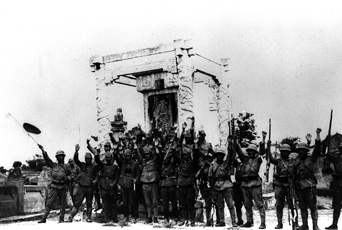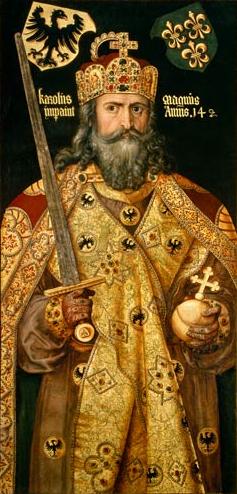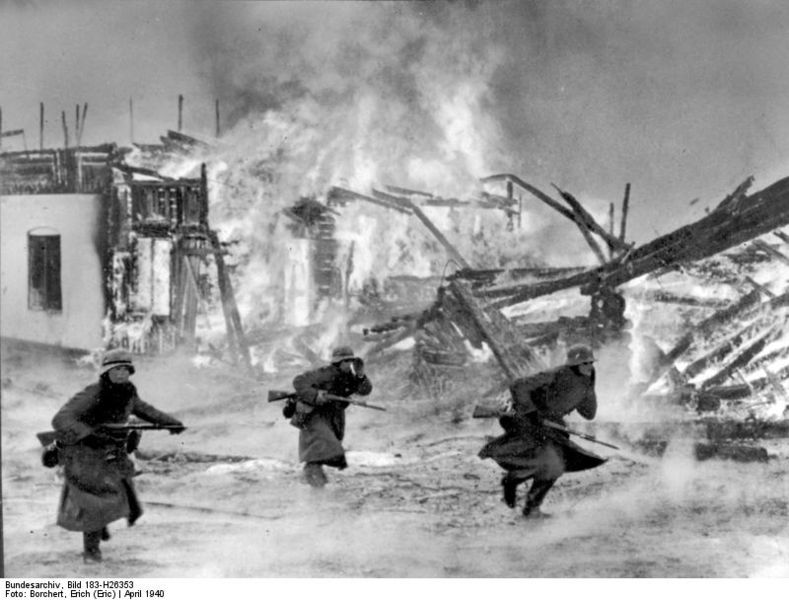For hundreds of years, the people of Serbia have considered the region of Kosovo to be the homeland of their history and culture. From the late 1300’s until 1912 however, this area was ruled by the Ottoman Turks, an Islamic people who once controlled a vast empire. Over the course of Ottoman Turkish rule, many Serbs either left Kosovo or converted from Christianity to Islam. Also, the Albanian Muslim (a Muslim is someone who believes in Islam) population of the area grew, until the majority of Kosovo inhabitants were no longer Serb Christians.
Albanians and Serbs are quite different in terms of language, religion and culture. Ever since Serbia acquired Kosovo in the First Balkan War (1912), conflict between these two groups has erupted periodically in this disputed region.
Below is a listing of these conflicts accompanied by a brief description.
NOTE: For the purposes of categorizing these conflicts, the term "Kosovo War" is used to name the wars between Serbs and Kosovar Albanians. Also, the use of the Serb term "Kosovo" rather than the Albanian version "Kosova" is not meant to imply favoritism or bias. "Kosovo" is the name that most Americans and Westerners know the region by and that is the name used here for clarity.
First Kosovo War (1912-1913)–In the brief First Balkan War (1912-1913), Serbia, along with other Balkan nations, succeeded in ending Ottoman Turkish rule in south-eastern Europe. As a consequence of this war, Albania became independent and the largely Albanian-inhabited region of Kosovo became a part of Serbia. Serbs had long claimed this area, citing its history as a part of the Serbian Kingdom which existed in the Middle Ages.
The Kosovars had already begun a rebellion against the Turks and wished to join with the new nation of Albania. Occupying Serb and Montenegrin troops and Kosovo guerrillas clashed. In the fighting and subsequent repression, approximately 20,000 Kosovars perished, while tens of thousands more fled to other countries. Many atrocities were carried out by the "kamitadjis," Serb paramilitary forces which officially operated independently of the Serb army but engaged in brutal repression of the civilian population. Note that in the Bosnian and Kosovo Wars of the 1990’s, Serb paramilitary forces in the same vein as the kamitadjis operated freely.
Second Kosovo War (1915-1918)–This conflict can be considered a part of World War One. Serbia was invaded by the armies of Austria-Hungary, Germany and Bulgaria (along with Turkey they were known as "The Central Powers"). The Serb army and government fled before the armies of the Central Powers in the winter of 1915. They marched through the mountains of Kosovo and Albania toward the sea where naval ships of the British and French (known as "The Allies") rescued them to continue the war from bases in Greece. During this retreat through Albanian-populated areas, the Kosovars exacted revenge on the Serbs for their conquest a few years earlier. Albanian guerrillas ambushed small units, killed and mutilated soldiers who became cut off from the main Serb forces and generally made the retreat as difficult as possible for the Serb army. Between the attacking Central Powers, the Albanians and the weather, roughly half of the 300,000 Serb soldiers who began the retreat never made it to the sea. The Albanian rebels, or "kaçaks" as they were called, also fought against the Austro-Hungarian and Bulgarian occupiers of Kosovo.
Third Kosovo War (1918-1924)–With the defeat of the Central Powers, Serbia joined with Montenegro and the formerly Austro-Hungarian areas of Slovenia, Bosnia and Croatia to form the new nation of Yugoslavia. The new kingdom’s government and army were dominated by Serbs. The king of Serbia became the first king of Yugoslavia, and the Yugoslav army was created with the old Serb army as its nucleus.
The Serb/Yugoslav army reoccupied Kosovo in 1918 but faced resistance from the Albanian Kosovar kaçaks, who did not want a return to Serb rule. As the army re-imposed government rule, many atrocities occurred, in part fueled by Serb desire for revenge over the harassment they suffered in the retreat of 1915. Massacres and the burning of villages were tactics employed to break the back of the rebel resistance. The Yugoslav government also banned the teaching of the Albanian language in the schools and encouraged immigration of Serbs and Montenegrins into Kosovo from other parts of Yugoslavia.
The rebels based in northern Albania formed the Committee for National Defense of Kosovo, also known as the Kosovo Committee or "KK" for short. The KK smuggled arms across the border and conducted raids against government forces. In May, 1919, the KK called for a mass uprising in Kosovo, and nearly 10,000 poorly armed rebels were driven into the mountains by a Yugoslav army equipped with modern machine guns and artillery. The KK continued the guerrilla struggle from bases in northern Albania until 1924. In that year, Yugoslavia’s military helped Ahmed Zogu, Albania’s former Prime Minister, regain power. In 1923, the KK had aided in Zogu’s overthrow from their bases in northern Albania. In return for Yugoslavia’s military aid, Zogu (who later became King Zog), closed down the KK’s guerrilla bases and effectively ejected them from Albania. This brought an end to the armed struggle in Kosovo.
Fourth Kosovo War (1941-1944)–This conflict can be considered a part of World War Two. In 1941, Germany, Italy and Bulgaria (the "Axis") invaded Yugoslavia and divided the country between them. Kosovo was occupied by the Italians, who attached it to Albania, which had been conquered by Italy in 1939. Most Kosovar Albanians welcomed the Italian occupiers, especially when Axis forces stood by and did not interfere as gangs of Kosovar Albanians attacked Serb and Montenegrin settlers. It is estimated that between 3,000 and 10,000 Serbs died and 30,000 and 100,000 fled Kosovo in this period. After Italy’s surrender to the Allies on September 8, 1943, German forces occupied Kosovo and Albania. The Germans encouraged attacks against the Serbs and used local Albanians to help them round up local Jews for their death camps.
While no extensive resistance to the Axis developed in Kosovo, most of the central portion (Bosnia-Hercegovina and Montenegro) of the old Yugoslavia was embroiled in bloody warfare against the Germans and Italians. The Communist Partisan army of Josip Broz Tito waged an effective guerrilla campaign which tied down hundreds of thousands of Axis soldiers. Most Kosovo Albanians distrusted the Partisans due to the perception that it was a largely Serbian organization and because most Muslim Albanians were anti-Communist. Some Kosovo Partisan units were formed and began striking at Axis forces in early 1943, but by and large, the Communist Partisan organization in Kosovo was quite weak.
In order to encourage more Kosovo Albanian participation in the war against the Axis, Tito announced in January, 1944, that after the war Kosovo would have the right to secede from Yugoslavia and join with Albania. Tito never intended to abide by this declaration and when Partisan units liberated Kosovo from the Germans in late 1944, a new conflict began in the Drenica valley of Kosovo.
Drenica Rebellion (or Polluzha’s Rebellion) (Late 1944-March 1945)–Shaban Polluzha was a Kosovar Albanian Partisan leader who believed Tito’s declaration that Kosovo could join with Albania. When he was ordered to take his 8,000 Kosovo Partisans north into Croatia to combat German troops, he refused, sparking an attack by the Titoist Partisan army. It is estimated that 20,000 Kosovar Albanians joined his rebellion. During the fighting and later Yugoslav Partisan reprisals, some 44 villages were reported destroyed. Tito’s forces put down the rebellion completely. After the war, Tito became the dictator of a Communist Yugoslavia. During his reign, Tito managed to suppress nationalist and ethnic tensions thoughout Yugoslavia.
Pristina Student Demonstrations (Spring, 1981)–After Tito’s death in 1980, Yugoslavia began to show signs of dissolution. On March 11, 1981, a small university student demonstration in Kosovo’s capital of Pristina turned into a general plea for democracy and Albanian nationalism. The students were somewhat influenced by the recent rise of the Solidarity movement in Communist Poland. On March 26, students and police clashed, leaving 37 injured. High school students and factory workers joined the protests demanding either Kosovo independence or union with Albania. At this point, Yugoslav special police with tanks entered Pristina. In the violence that followed, the government claims only eleven died and 57 were injured. Other reports put the death toll at hundreds. After the protests were broken up, thousands were arrested and put on trial.
It should be noted though, that administration of Kosovo was in the hands of local Albanian Communists, and this should not be interpreted as a strictly Serb-Albanian conflict. The protests were directed more at the Yugoslav government as a whole.
Sixth Kosovo War (1998-1999)–The Kosovo Liberation Army began a guerrilla war in February, 1998 against Serb Yugoslav authority. On March 24, 1999, in response to atrocities committed by the Serbs and their unwillingness to negotiate at the peace table (The Rambouillet Conference), the North Atlantic Treaty Organization (NATO) began a 78-day air campaign which succeeded in causing Serb leader Slobodan Milosovic to withdraw his army from Kosovo.
Kosovo Secession from Serbia (Feb. 17, 2008)–After existing as a UN-Administered part of Serbia since the 1998-1999 Kosovo War, the government of Kosovo declared its independence from Serbia. The Serbian government opposed this secession.
LINK: http://www.historyguy.com/kosovar_serb_warfare.html
SOURCES:
1. Judah, Tim. Kosovo: War and Revenge. New Haven: Yale University Press, 2000.
2. Ignatieff, Michael. Virtual War: Kosovo and Beyond. New York: Metropolitan Books, 2000.
3. Stavrianos, L.S. The Balkans Since 1453. New York,New York: Holt, Rinehart and Winston, 1966.
History: Independent Albania–http://www.albanian.com/main/history/independent.html
Please cite this source when appropriate:
Lee, Roger A. "The History Guy: Warfare and Conflict Between Kosovar Albanians and Serbs Since 1912"
http://www.historyguy.com/kosovar_serb_warfare.html
Copyright © 1998-2008 Roger A. Lee and History Guy Media; Last Modified: 02.17.08



